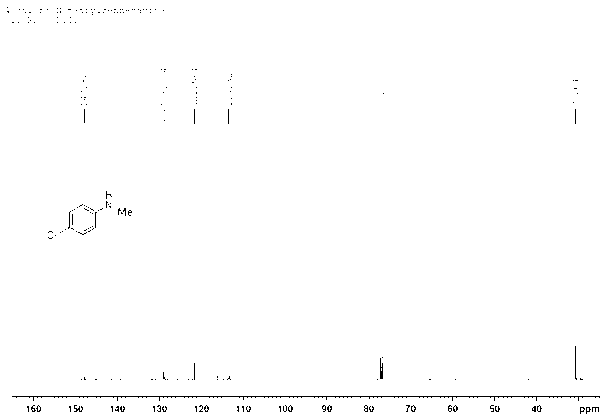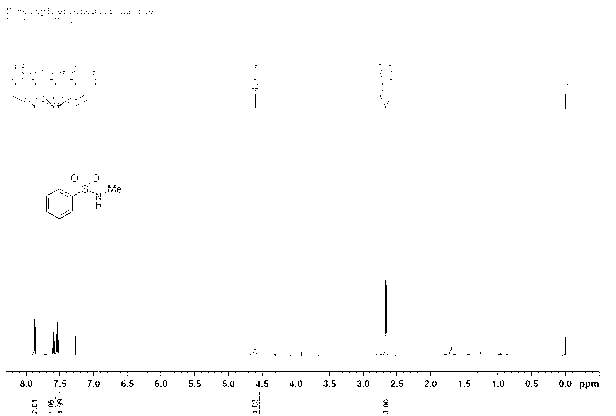Method for realizing selective N-methylation of primary amine
A methylated primary amine, selective technology, applied in the field of selective N-methylated primary amine, to achieve broad development prospects and industrial value, high economic efficiency, wide substrate versatility
- Summary
- Abstract
- Description
- Claims
- Application Information
AI Technical Summary
Problems solved by technology
Method used
Image
Examples
Embodiment 1
[0027] 4-Chloro-N-methylaniline
[0028] 4-chloro-N-methylbenzonamine
[0029]
[0030] 4-Chloroaniline (255 mg, 2 mmol), [Cp*IrCl 2 ] 2 (1.6 mg, 0.002 mmol, 0.1 mol%), sodium hydroxide (80 mg, 2 mmol) and methanol (1 ml, 790 mg, 24.7 mmol, 12.4 equiv.) were sequentially added to a 20 ml Schlenk reaction flask. The reaction mixture was at 150 o After 12 h at C, cool to room temperature. The solvent was removed by rotary evaporation, and then the pure target compound was obtained by column chromatography (developing solvent: ethyl acetate / petroleum ether), yield: 96%. The H NMR and C NMR spectra of the product are as follows: figure 1 with figure 2 as shown,
[0031] 1 H NMR (500 MHz, CDCl 3 ) δ 7.11 (d, J = 8.8 Hz, 2H, ArH), 6.51 (d, J = 8.8 Hz, 2H, ArH), 3.69 (br s, 1H, NH), 2.79 (s, 3H, CH 3 ); 13 C NMR (125 MHz, CDCl 3 ) δ 147.8, 128.8, 121.5, 113.3, 30.6.
Embodiment 2
[0033] 3-Chloro-N-methylaniline
[0034] 3-chloro-N-methylbenzonamine
[0035]
[0036] 3-Chloroaniline (255 mg, 2 mmol), [Cp*IrCl 2 ] 2 (1.6 mg, 0.002 mmol, 0.1 mol%), sodium hydroxide (80 mg, 2 mmol) and methanol (1 ml, 790 mg, 24.7 mmol, 12.4 equiv.) were sequentially added to a 20 ml Schlenk reaction flask. The reaction mixture was at 150 o After 12 h at C, cool to room temperature. The solvent was removed by rotary evaporation, and then the pure target compound was obtained by column chromatography (developing solvent: ethyl acetate / petroleum ether). Yield: 90%.
[0037] 1 H NMR (500 MHz, CDCl 3 ) δ 7.06 (t,J = 8.1 Hz, 1H, ArH), 6.65 (d, J = 7.9 Hz, 1H, ArH), 6.55 (s, 1H, ArH), 6.45 (dd, J = 8.3 Hz and 2.3Hz, 1H, ArH), 3.76 (br s, 1H, NH), 2.79 (s, 3H, CH 3 ); 13 C NMR (125 MHz, CDCl 3 ) δ 150.3, 134.9, 130.0, 116.8, 111.8, 110.7, 30.4.
Embodiment 3
[0039] 4-Bromo-N-methylaniline
[0040] 4-bromo-N-methylbenzonamine
[0041]
[0042] 4-Bromoaniline (344 mg, 2 mmol), [Cp*IrCl 2 ] 2 (1.6 mg, 0.002 mmol, 0.1 mol%), sodium hydroxide (80 mg, 2 mmol) and methanol (1 ml, 790 mg, 24.7 mmol, 12.4 equiv.) were sequentially added to a 20 ml Schlenk reaction flask. The reaction mixture was at 150 o After 12 h at C, cool to room temperature. The solvent was removed by rotary evaporation, and then the pure target compound was obtained by column chromatography (developing solvent: ethyl acetate / petroleum ether), yield: 88%
[0043] 1 H NMR (500 MHz, CDCl 3 ) δ 7.24 (d, J = 8.9 Hz, 2H, ArH), 6.46 (d, J = 8.9 Hz, 2H, ArH), 3.70 (br s, 1H, NH), 2.79 (s, 3H, CH 3 ); 13 C NMR (125 MHz, CDCl 3 ) δ 148.1, 131.7, 113.8, 108.5, 30.5.
PUM
 Login to View More
Login to View More Abstract
Description
Claims
Application Information
 Login to View More
Login to View More - R&D
- Intellectual Property
- Life Sciences
- Materials
- Tech Scout
- Unparalleled Data Quality
- Higher Quality Content
- 60% Fewer Hallucinations
Browse by: Latest US Patents, China's latest patents, Technical Efficacy Thesaurus, Application Domain, Technology Topic, Popular Technical Reports.
© 2025 PatSnap. All rights reserved.Legal|Privacy policy|Modern Slavery Act Transparency Statement|Sitemap|About US| Contact US: help@patsnap.com



